A look at the results of CANactions 2014's "User-generated Kyiv" competition
By Bustler Editors|
Thursday, Jul 10, 2014
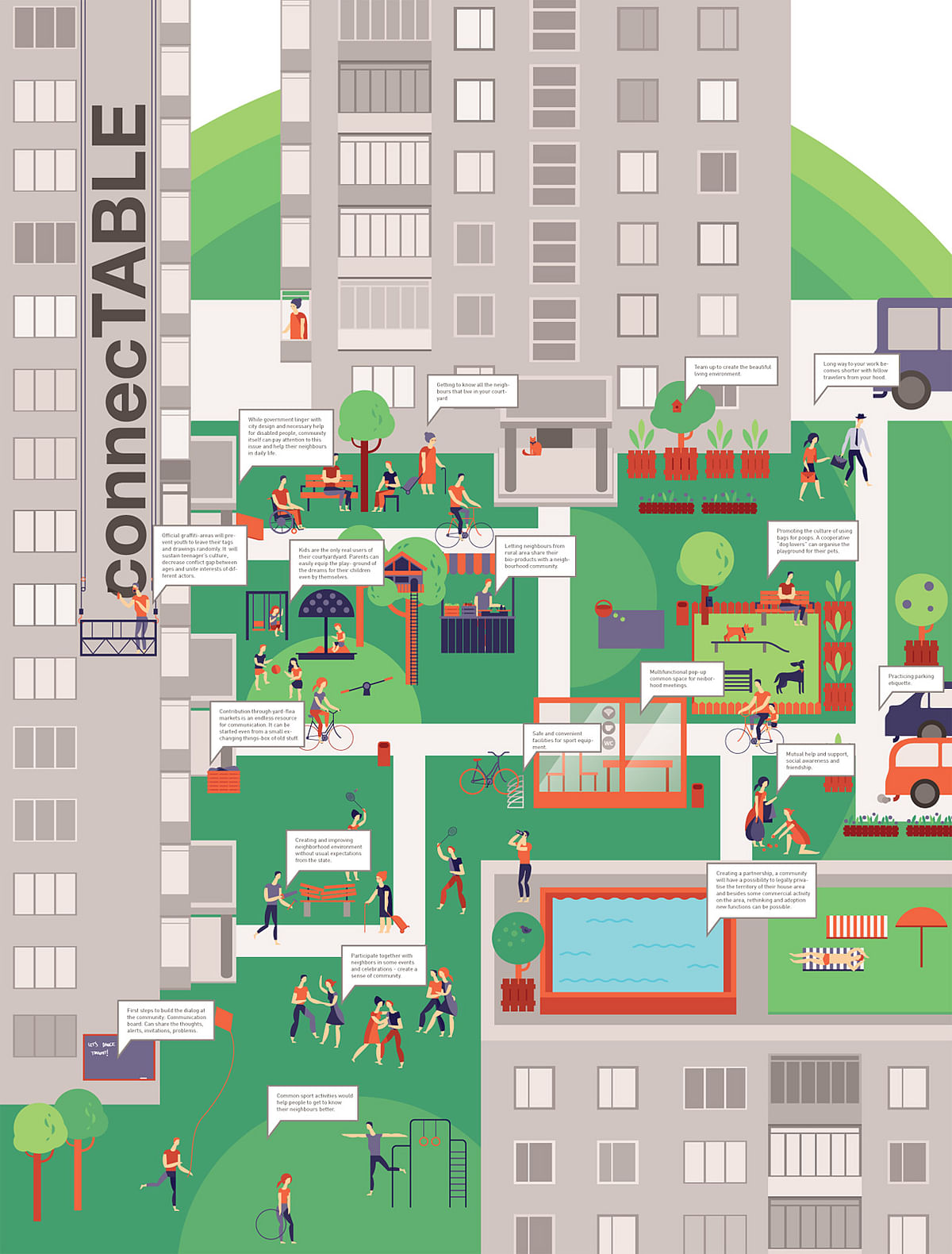
Related
Ukraine's largest architectural event CANactions held its 2014 ideas competition, whose theme was "User-generated Kyiv". Based on reinforcing the valuable idea that a city is shaped by its citizens, the competition sought architectural ideas to help Kiev further develop towards the ideals of creativity, peace, justice, and of course, happiness.
The jury, which included notable names like artist Ai Wei Wei, awarded three top prizes:
- 1st prize (US$3,000): "connecTABLE" by Anna Dobrova, Dima Isaiev, Dasha Zaichenko, Daryna Bagachuk, Anna Kamushan (Vienna, Austria)
- 2nd prize (US$1,500) : "POP-UP KIEV" by Polina Timofeeva, Galyna Tolkachova, Pavel Bartov (Perm, Russia)
- 3rd prize (US$500): "Reload the symbols" by Kateryna Bokatova and Frederic Vincent (Bordeaux, France)
Four Special Prizes were also chosen:
-
Special Prize: participation inIFAC (International Festival of Art and Construction)
- "Augmented City" by Polina Timofeeva, Galyna Tolkachova, Pavel Bartov (Kiev, Ukraine) -
Special Prize: architectural trips to Switzerland from Swiss Embassy in Ukraine
- "The stage" by Andriy Grytsay, Maxim Klotchenko, Anna Morgunova (Dnepropetrovsk, Ukraine)
- "Revival of the Green Material and Blue Arteries" by Cemen Polomanyi, Sergiy Golomakh, Oleksiy Liashok, Ruslan Sydorenko, Maryna Karpenko, Vitaliy Tkach, Iryna Prokopchuk (Kiev, Ukraine)
- "Start" by Olga Konovalova, Nataliia Shulga (Kiev, Ukraine)
A selection of other notable entries were exhibited during the festival, such as the "Kyiv FORUM".
Take a gander at the winning projects below.
1st prize: connecTABLE by Anna Dobrova, Dima Isaiev, Dasha Zaichenko,Daryna Bagachuk, Anna Kamushan (Vienna, Austria)
Project description:
"Idea - We perceive our project as a social one, which in perspective will have a strong impact on the life of environment, structure of governance and state programs. Our aim is to create a platform not only for dialogue but also for a common act. Communication here is a tool for participation and action; social engagement is a base of political responsibility. Practicing different initiative scenarios at a dormitory suburb’s courtyard we will introduce the new patterns of cohabitation, based on self- organization and active participation instead of waiting for downstream benefit from the governmental organizations. To extend educational effect of our project to the physical activity level, we will use participatory method for community design. The implementation of the simplest streets design solutions would elaborate communicational and cooperational skills of courtyard dwellers, create a quick satisfactory result as an outcome and realienate dwellers to their life environment. On the whole, our methods, covering a wide range of skills for physical and social activities, would have a multi effect: educational, political, entertaining.
Methods - Exploring the possibility of social engagement at the dormitory suburbs with a case study of city Kyiv, we were searching for mechanisms of increasing cooperation and communication abilities among the neighbors. Looking at the space of the cour- tyards as a spatial system, diving into existing governmental programs and structure of ownership, we come up with an idea of connecTABLE Fest as a starting point for social interconnectivity. The goal of the festival is to make neighbors meet each other and start communicating. Being located at probably the most homogeneous entourage of modernist microrayon, nevertheless our intention is to create the most comfortable environment for communication, with a flexible normativity for neighbor sociali- zing. Thus, referring to the traditional culture of conversation, dinner time and family atmosphere, we imagine a long table appearing here. A symbolic place for communication. The table with different playful and educational activities for dwellers, will be a precedent for people’s connection. During the festival people are invited to play a game in which they could create, enter- tain, and learn their neighborhood by doing simple things like having dinner together, doing sports, playing with kids, improving infrastructure with their own hands or taking part in local forum.
Vision - In the end, what is the message we leave dwellers with? Starting with a first small step of 2-day Festival at the dormitory suburb, we appeal to self responsibility and acting versus passivity. Through communication, a catching virus among the neighbors of self organization and initiative would appear. We see politicisation of localities and cooperation of people towards the self-governing already at the smallest community cell. We see monolog of governance becomes a dialogue with citizens, due to collaboration of courtyard ‘unions’ and partnership with municipalities. Furthermore, changing the principal criteria for decision making leads to transformation of the city economy and its management. As result, all those consistent alterations lie at the base of reorganization of power and economy vertical pyramid structure into a horizontal and social one. Although, we are prisoners of existing microrayon grid, we can still change the social and cultural environment and thereby a city landscape. Therefore, the platform for communication and self organization created at the ConnecTABLE Fest will be a projection of Maidan situation into life, where mutual interest can bring immediate changes."
Find more of the project description here.
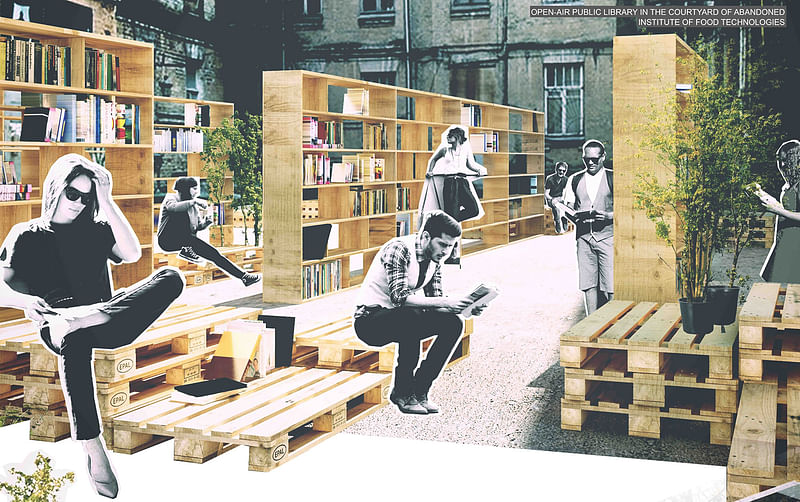
2nd prize: POP-UP KIEV by Polina Timofeeva, Galyna Tolkachova, Pavel Bartov (Perm, Russia)
Project description:
"Pop-up. What does it mean? Is it a new way of temporary architecture? Or it means just a popular public space? Probably both opinions are right. But in our vision, pop-up space is, first of all, a contemporary method to affect and inspire people. Any pop-up intervention reacts on unutilized space. Abandoned and left-over territories in the urban context of Kyiv grow continuously nowadays and have spontaneous character. Unfortunately not always the issue of abandonment aspires to be solved. Thus, this problem must be “pop-uped” – marked on the interactive map of Kyiv and highlighted by tactical urbanism interventions.
Our proposal aims to duplicate close to abandoned building its former function showing the “soul” of abandonment and create a public space that will generate people intensity. This way of pop-up intervention will not only draw attention of government and investors to rediscover abandoned territories but also will become a “platform” for citizen’s initiative and show a vector for future development of the spaces.
The project takes a root in using one of the cheapest and easy shaping module as wooden pallet. Its flexibility and modularity allows to use it for any function of the neglected space and being generated by citizens. On a practical way we have chosen three buildings of Kyiv – the abandoned cinema named after Gagarin on Shchusieva Street, the former Institute of Food Technologies on Tarasivska Street and ex-kindergarten on Druzhbi Narodov Boulevard. We suggest people to transform the adjusted environment into new qualitative space with the same functions of building behind, taking into consideration a possibility to use this approach through all “abandoned” city of Kyiv. Within our project we cannot say we solve the problem of abandonment spaces in Kyiv or we found the way of future development of the city, but we surely can say: “Welcome to pop-up Kyiv – to the city YOU create”!"

3rd prize: Reload the symbols by Kateryna Bokatova and Frederic Vincent (Bordeaux, France)
Project description:
"The revolution doesn’t mean destruction. It’s useless and vain to destroy our heritage. It is better to reload the system through its symbols. Could we imagine to hijack public buildings which symbolise authoritarianism and corruption ? The power of Maïdan is based on essentials values such as sharing, innovation and support, brought to life by the public space and art. These values must be preserved and reintroduced into the economic, societal and scientific development of the city to allow citizens to be actors in the changes of the city. Indeed, the city is structured around the places of public and economic power. The link between them is constantly changing according to various rhythms of the use of public spaces.
We tried to organise these services in three types:
- place of public decision (town halls, parliament, ministries, ...) – transformed to valorise sharing of information, public communication.
- place of justice and authority (police stations, courthouses) – transformed to support, defend the rights of citizens.
- place of economy and knowledge (universities, fair expo-centre, trade-union building) – transformed to be the field of innovation and creation.
So we seek to introduce light and ephemeral structures as support of new and experimental functions. The goal is to initiate change into the content and the form of institutions but in a soft, simple, happy and beautiful way. In building terms, we chose scaffolding systems as the preferred means of intervention. Light structure and quick to assembled, it symbolises the transformation and allows an infinite possibility assemblies. Transparent and lightweight materials provide covering and insulation thanks to double skins systems or specific airlock spaces. This type of installations presents numerous variations and a great ability to adapt to the surrounding. They create a formal contrast who questions and hijacks without destroying. On the contrary, they give off a spatial and functional potential.
As places of all possibilities, these installations aim to give an impulse to the institution into their relation with citizens and public space, in the dynamic of the Maïdan revolution. They make a better way for imagination to hijack the symbols of an opaque and corrupted power and to allow citizens to appropriate the changes of their city. They aim to symbolise strength and hope, stemmed from an unstable balance of art and desire."
Find more of the project description here.
Jury:
- Ai Weiwei, Beijing/China
- Haris Piplas: Urban-Think Tank, ETH Zurich, Zurich/ Switzerland
- Heribert Wolfmayer: Heri&Salli; Architects, Wien/ Austria
- Stefano Regazzo: Orizzontale Architects, Rome/ Italy
- Marc Jay: WE architecture Copenhagen/Denmark
- Bohdan Cherkes: Lviv Polytechnic National University, Lviv, Ukraine:
- Sergey Tselovalnic: Chief architect Kyiv, Kyiv/ Ukraine:
Click the thumbnails below to see each project's panel and the Special Prizes.
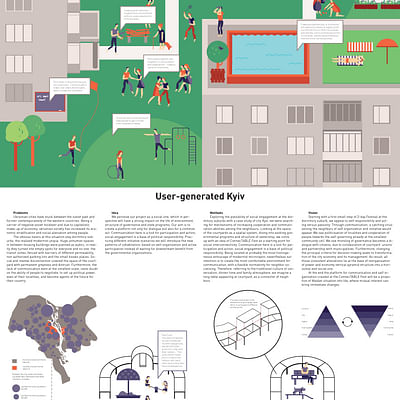
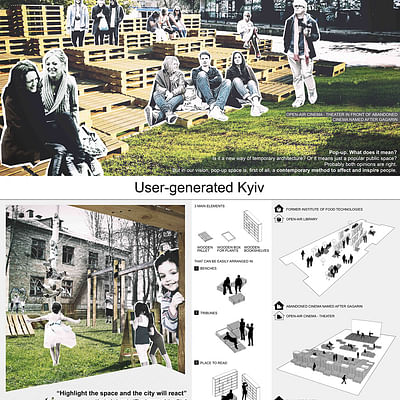

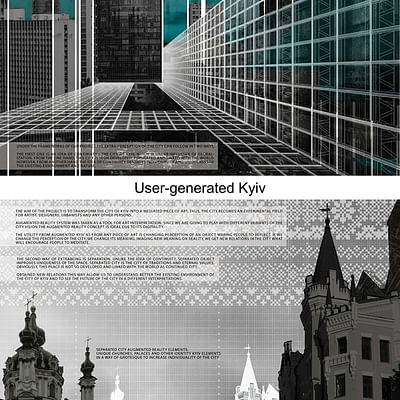

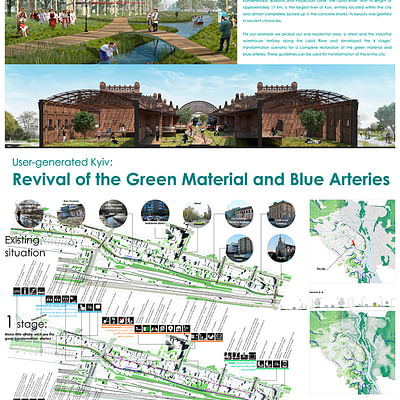


Share
0 Comments
Comment as :